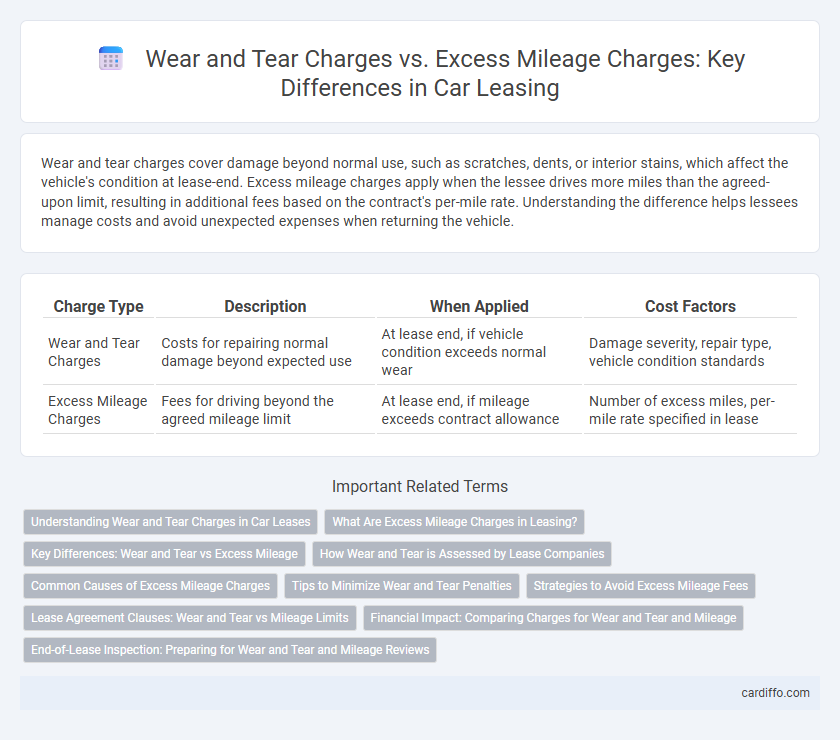Wear and tear charges cover damage beyond normal use, such as scratches, dents, or interior stains, which affect the vehicle's condition at lease-end. Excess mileage charges apply when the lessee drives more miles than the agreed-upon limit, resulting in additional fees based on the contract's per-mile rate. Understanding the difference helps lessees manage costs and avoid unexpected expenses when returning the vehicle.
Table of Comparison
| Charge Type | Description | When Applied | Cost Factors |
|---|---|---|---|
| Wear and Tear Charges | Costs for repairing normal damage beyond expected use | At lease end, if vehicle condition exceeds normal wear | Damage severity, repair type, vehicle condition standards |
| Excess Mileage Charges | Fees for driving beyond the agreed mileage limit | At lease end, if mileage exceeds contract allowance | Number of excess miles, per-mile rate specified in lease |
Understanding Wear and Tear Charges in Car Leases
Wear and tear charges in car leases cover damages exceeding normal usage, such as dents, scratches, and interior stains, which reduce the vehicle's resale value. These charges differ from excess mileage fees, which apply only if the lessee drives beyond the agreed mileage limit. Understanding the specific wear and tear guidelines in the lease agreement helps lessees avoid unexpected end-of-lease costs and maintain the vehicle's condition within acceptable standards.
What Are Excess Mileage Charges in Leasing?
Excess mileage charges in leasing refer to the additional fees a lessee must pay when they exceed the predetermined mileage limit set in the lease agreement. These charges are calculated per mile over the allotted mileage allowance, often ranging from $0.10 to $0.25 per mile, significantly impacting the total lease cost. Understanding excess mileage charges is crucial for lessees to avoid unexpected expenses and accurately budget for vehicle use during the lease term.
Key Differences: Wear and Tear vs Excess Mileage
Wear and tear charges refer to fees applied for physical damage or deterioration beyond normal usage on a leased vehicle, while excess mileage charges are imposed when the lessee exceeds the agreed-upon mileage limit in the lease contract. Wear and tear focuses on the condition of the vehicle's interior and exterior, including scratches, dents, or mechanical issues, whereas excess mileage strictly measures distance traveled beyond the lease terms. Understanding these key differences helps lessees manage potential end-of-lease costs effectively by monitoring vehicle usage and maintaining its condition.
How Wear and Tear is Assessed by Lease Companies
Lease companies assess wear and tear by conducting detailed inspections that compare the vehicle's current condition against manufacturer standards and lease agreement guidelines. Factors such as scratches, dents, tire tread depth, and interior stains are quantified to determine if damages exceed normal usage. This assessment directly influences the wear and tear charges applied at lease-end, differentiating from excess mileage fees which are calculated based on miles driven beyond the contract limit.
Common Causes of Excess Mileage Charges
Excess mileage charges on a vehicle lease commonly result from exceeding the predetermined annual mileage limit set in the contract, typically ranging between 10,000 and 15,000 miles per year. Frequent long-distance commutes, unplanned trips, and lifestyle changes such as new jobs or relocations often contribute to surpassing these limits. Unlike wear and tear charges that cover physical vehicle condition, excess mileage fees specifically address the additional depreciation caused by higher usage beyond the agreed terms.
Tips to Minimize Wear and Tear Penalties
To minimize wear and tear penalties on a leased vehicle, regularly perform maintenance such as tire rotations, oil changes, and brake inspections according to the manufacturer's schedule. Use protective measures like seat covers and floor mats to prevent interior damage. Avoid driving on rough terrain or taking unnecessary trips that can accelerate deterioration and lead to higher charges.
Strategies to Avoid Excess Mileage Fees
To avoid excess mileage charges on a lease, carefully estimate your annual mileage needs and choose a lease agreement with a higher mileage allowance if necessary. Regularly track your mileage using apps or odometer readings to stay within limits and plan trips efficiently to minimize unnecessary driving. Consider purchasing additional miles upfront if you anticipate exceeding the limit, as this is often cheaper than paying excess mileage fees at lease-end.
Lease Agreement Clauses: Wear and Tear vs Mileage Limits
Lease agreements typically include specific clauses outlining wear and tear charges and excess mileage charges to protect the lessor's asset value. Wear and tear clauses define acceptable vehicle condition parameters at return, while mileage limits restrict the total allowable miles to prevent excessive depreciation. Exceeding mileage limits triggers additional fees based on the excess miles driven, whereas wear and tear charges are assessed based on the vehicle's physical condition relative to normal use.
Financial Impact: Comparing Charges for Wear and Tear and Mileage
Wear and tear charges typically cover the cost of minor damages and depreciation beyond normal use, often impacting lease-end financial obligations significantly. Excess mileage charges are calculated per mile over the agreed limit, potentially leading to substantial additional fees if exceeded by a large margin. Comparing these charges reveals that excess mileage fees can accumulate faster than wear and tear costs, especially in high-mileage leases, influencing overall lease cost management.
End-of-Lease Inspection: Preparing for Wear and Tear and Mileage Reviews
End-of-lease inspections assess a vehicle's condition by evaluating wear and tear against manufacturer standards and reviewing mileage records to identify excess mileage charges. Proper documentation and maintenance history help minimize fees related to minor wear, while accurate mileage tracking prevents unexpected costs tied to exceeding contractual limits. Understanding lease terms and preparing for detailed inspections ensures a smoother transition and fair financial settlements.
Wear and Tear Charges vs Excess Mileage Charges Infographic

 cardiffo.com
cardiffo.com